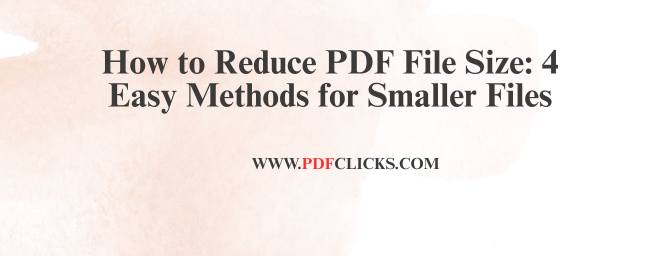In the fast-paced digital landscape of the United States, efficiency is currency. Whether you're a student emailing a research paper, a freelancer submitting a proposal, a small business owner sending invoices, or a corporate professional sharing reports, you've likely hit a common roadblock: the dreaded "file too large" error. That meticulously crafted PDF, packed with high-res images and fancy fonts, is suddenly rendered useless because it won't go through email or clogs up a shared drive.
The solution? Learning how to reduce the PDF file size. This isn't just about dodging email attachment limits; it's about improving workflow, saving precious storage space on your devices and cloud services, and ensuring your documents are easily accessible for clients and colleagues, even on slower connections.This guide will walk you through several effective methods, from built-in operating system tricks to powerful online tools, to help you shrink PDF files effortlessly.
Why Should You Compress PDF Files?
Before we dive into the "how," let's quickly cover the "why." Understanding what causes a PDF to bloat helps you choose the right compression strategy.
High-Resolution Images: This is the #1 culprit. A few photos from a modern smartphone camera can easily inflate a PDF to dozens of megabytes.
Embedded Fonts: To ensure your document looks the same on every device, PDFs often store entire font sets, which add to the file weight.
Document History and Metadata: Sometimes, PDFs retain editing history, comments, and other hidden data.
Inefficient PDF Creation: The method used to create the PDF (e.g., "printing" as a PDF vs. saving directly from a design tool) can significantly impact the initial file size.
Knowing this, your goal is to strategically reduce PDF size by targeting these elements without sacrificing unacceptable quality.
Method 1: The Built-In Saver – Using Adobe Acrobat's PDF Optimizer
If you have the premium version of Adobe Acrobat Pro (a staple in many American offices), you have a powerful tool already at your fingertips. Its "Optimize PDF" feature gives you granular control.
Steps to use this PDF optimizer:
Open your PDF in Adobe Acrobat Pro.
Go to File> Save As Other > Optimized PDF.
A dialogue box will open. Click on "Audit Space Usage..." to see a breakdown of what's taking up the most space—often images.
In the "PDF Optimizer" window, you can choose settings. Under "Images," you can downsample images to a lower DPI (e.g., 150 DPI is perfect for screen viewing and standard printing).
You can also remove embedded fonts, clear form fields, and discard other objects.
Click "OK" and save your new, optimized File.
This method is excellent for achieving precise control over reducing PDF file size, particularly for professional, recurring needs.
Method 2: The Online Powerhouse – Free PDF Compressor Tools
For most Americans without Acrobat Pro, free online tools are a lifesaver. They are incredibly user-friendly and require no software installation. Websites like Smallpdf, iLovePDF, and ILovePDF are trusted by millions. They are perfect for quickly determining how to reduce PDF file size on the fly.
How to use them:
Navigate to your chosen tool's website (e.g., Smallpdf's "Compress PDF" tool).
Drag and drop your oversized PDF file into the browser window.
The tool will usually process it automatically, applying a standard compression.
Some sites offer a choice between "Low," "Medium," and "High" compression. A higher compression will make the PDF smaller, but it may also reduce image quality more noticeably.
Download the compressed File.
A crucial reminder for a US audience: Always ensure you are using a reputable site with SSL encryption (look for "https://" in the address bar) when uploading sensitive documents. Delete your files from the server after download if the service offers that option.
Method 3: The Native Approach – Using Your Mac's Preview App
Apple users have a secret weapon built right into their macOS: the Preview app. It's a simple and effective way to decrease file size without any third-party software.
Here's the simple process:
Open the PDF in the Preview app (this is usually the default).
Click on File> Export.
In the export dialogue box, look for a "Quartz Filter" dropdown menu.
Select "Reduce File Size" from the list.
Click "Save."
This applies a blanket compression that is often very effective for simple documents and image-heavy PDFs, providing a fantastic answer for Mac users wondering how to reduce PDF file size natively.
Method 4: The Universal Trick – Re-Printing as a PDF
This clever workaround works on both Windows and Mac and can be surprisingly effective. It essentially forces your computer to re-process the entire document, often stripping out bulky elements in the process.
Open your original, large PDF file.
Select the "Print" option.
In the printer selection menu, choose "Microsoft Print to PDF" (on Windows) or "Save as PDF" (on Mac). Do not use an actual physical printer.
Click "Print" or "Save." You will be prompted to name and save a new PDF file.
This new File is often significantly smaller. It's a great first attempt at shrinking PDF file sizes, although it may not handle complex elements like form fields perfectly.
Choosing the Right Method for You
For Maximum Control: Use Adobe Acrobat Pro's PDF optimizer.
For Convenience and Speed: Use a free online tool to compress PDF files.
For Mac Users: Use Preview's export function to reduce PDF size quickly.
As a quick first try, use the re-print method on any computer to decrease file size.
Mastering the skill of reducing PDF file size is a small but powerful way to enhance your digital productivity. By using these methods, you can ensure your documents are always professional, transferable, and efficient—saving you time, bandwidth, and frustration.
